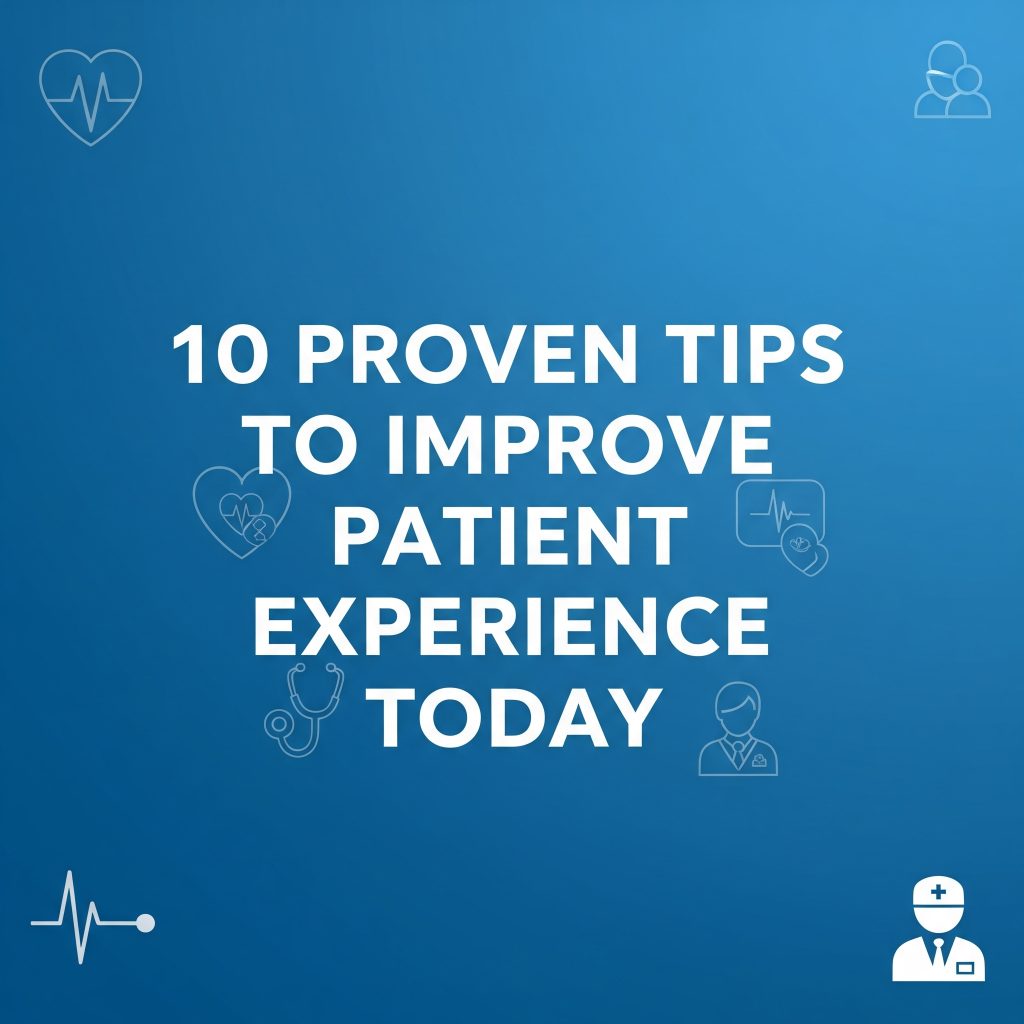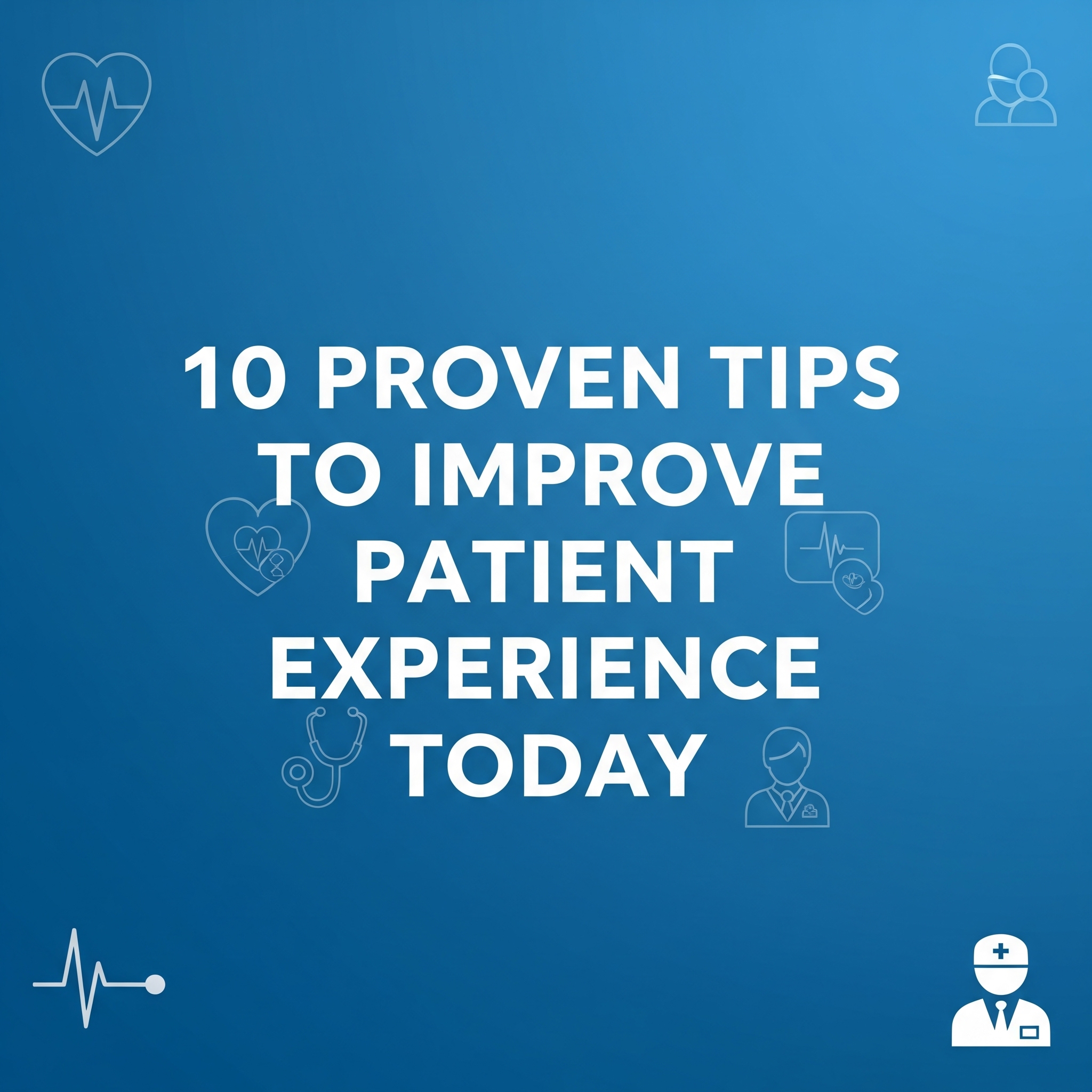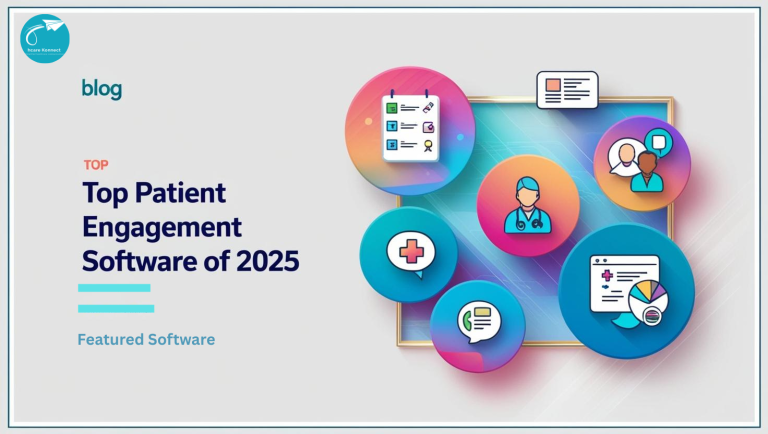10 Proven Tips to Improve Patient Experience Today

Improving patient experience is essential for both patient satisfaction and healthcare outcomes. This article offers 10 actionable tips that healthcare providers can implement now to improve patient experience. Learn how to streamline wait times, use technology effectively, and more.
Key Takeaways
- Improving patient experience positively impacts health outcomes and provider loyalty, making it a key focus for healthcare organizations.
- Streamlining processes, such as reducing wait times and enhancing communication, significantly enhances patient satisfaction and care quality.
- Utilizing technology and personalizing care are essential strategies for engaging patients and improving their overall healthcare experiences.
The Importance of a Positive Patient Experience
A positive patient experience is not just a feel-good factor; it has tangible impacts on health outcomes and patient adherence. Studies have shown that patients who have positive healthcare experiences are more likely to adhere to medical advice, leading to better health outcomes. This adherence is crucial for effective treatment and recovery, making patient experience a central aspect of patient care.
Beyond individual health benefits, improving patient experience can significantly affect healthcare providers’ business outcomes. High patient satisfaction leads to greater patient loyalty, which is critical for healthcare providers. On the flip side, patients who are dissatisfied with their healthcare experiences are less likely to return or recommend the organization, negatively impacting the provider’s reputation and financial performance.
The importance of patient experience extends beyond individual satisfaction. It encompasses the entire patient journey, from the first point of contact to the final follow-up. Focusing on creating positive healthcare journeys promotes better health outcomes and enhances overall patient safety and satisfaction.
Incorporating patient experience into the Quadruple Aim of healthcare—improve the patient experience for both patients and clinicians—underscores its significance. Thus, healthcare providers must prioritize patient experience to foster a culture of continuous improvement and excellence in care delivery.
Streamlining Wait Times for Better Satisfaction

Long wait times are a significant source of frustration for patients and one of the most common issues they face. To reduce wait times and improve patient satisfaction, consider the following:
- Implement effective scheduling methods.
- Avoid overbooking appointments.
- Keep patients informed about wait time updates, which can greatly diminish their frustration during visits.
Regular updates on delays and effective scheduling lead to enhanced patient experience and satisfaction. Providing timely care improves patient loyalty and creates a more positive patient journey. This approach not only benefits patients but also helps staff members manage their time more efficiently, contributing to overall continuous improvement in healthcare delivery.
Minimizing wait times is crucial for improving patient satisfaction. Simple strategies like keeping patients informed and optimizing appointment schedules can make a significant difference in the patient experience, fostering a sense of respect and care.
Creating a Comfortable Environment

The physical environment of a healthcare facility plays a vital role in shaping the patient experience. Practicing hand hygiene and maintaining a sanitary environment are fundamental to patient safety and can significantly reduce the spread of pathogens. This creates a sense of security and well-being for patients, knowing they are in a clean and safe environment.
Comfortable waiting areas with features like comfortable chairs, charging stations, and snacks can greatly enhance physical comfort. Access to natural light and maintaining comfortable room temperatures further contribute to important aspects of a positive patient experience. These small but impactful changes can make patients feel more at ease during their visits.
Incorporating artwork and calming colors in healthcare environments can help reduce patient anxiety, and Improve Patient Experience, making the overall experience more pleasant. The layout of waiting areas, including adequate space and seating arrangements, also influences patient perceptions of comfort. Creating a welcoming and comfortable environment significantly improves patient satisfaction and overall well-being.
Effective Communication with Patients
Effective communication is the cornerstone of high-quality healthcare. It significantly affects clinical outcomes and the overall patient experience. Good communication between patients and clinicians contributes to lower mortality rates and reduced infection rates. Patients are more likely to disclose sensitive information when they feel safe and comfortable with their healthcare providers.
Active listening allows healthcare providers to better understand patient concerns and encourages open dialogue. Using plain language rather than medical jargon enhances patients’ understanding of their treatment and conditions. This clarity is crucial for ensuring that patients adhere to their treatment plans and make informed choices about their care.
Sitting down during consultations can foster a more trusting and intimate relationship between the patient and provider. Here are some recommended practices:
- Greet the patient using their preferred name.
- Sit facing the patient and maintain eye contact.
- Engage in relevant conversation to build rapport and trust.
- At the end of each visit, request verbal confirmation from patients to ensure understanding of the treatment plan.
Ensuring confidentiality in communication is vital for building trust and protecting patient information. Healthcare organizations should hire interpreters to facilitate communication with patients who speak different languages. Employing culturally responsive communication techniques helps bridge gaps between patients and providers.
Effective communication is essential in healthcare, as it can lead to better health outcomes and higher patient satisfaction. Prioritizing clear, empathetic, and culturally sensitive communication significantly improves the patient experience.
Involving Patients in Their Own Care
Involve patients in their own care is a powerful strategy for improving patient satisfaction and outcomes. Patients who actively engage in their healthcare decisions tend to adhere better to treatment plans and experience fewer complications. Shared decision-making allows patients to collaborate with healthcare professionals in decisions regarding their clinical exams and treatment options in their own right.
Patients who feel their treatment options and care plans are aligned with their preferences show higher satisfaction with their healthcare experience. Nurses’ involvement in shared decision-making may enhance patients’ understanding of their conditions and treatment options. This collaborative approach empowers patients and fosters a sense of ownership over their health within their care team.
Training healthcare professionals in effective communication can improve the quality of patient engagement in their care. Health care providers are utilizing AI to create predictive models that tailor treatment plans based on individual patient data. A significant portion of patients express a desire for enhanced functionalities in their EHRs, reflecting a trend toward greater engagement.
Involving patients in their own care improves adherence, satisfaction, and overall health outcomes. This approach emphasizes the importance of patient-centered care and encourage patients to take an active role in their patient’s health journey, ensuring that the patient understands their treatment options and the value of self care.
Leveraging Technology to Improve Patient Experience

Technology offers numerous opportunities to enhance the patient experience. Patient-facing EHR tools enable individuals to engage with their health records and connect external health data sources. This transparency allows patients to monitor their health more effectively and make informed decisions about their care.
Recent advancements in EHR technology support remote patient monitoring and virtual med care, particularly highlighted during the COVID-19 pandemic. The ability to link personal health devices to EHRs allows patients to centralize their health data from various sources. This integration simplifies the management of health information and improves the continuity of care.
Simplified administrative processes in hospitals are designed to minimize patient burdens, allowing them to focus on health rather than paperwork. These processes include:
- Centralized communication among staff
- EHR integration
- Real-time alerts via QR codes
- Providers setting reminders for follow-up commitments to keep patients engaged in their care
Leveraging technology in the healthcare system can streamline care delivery, improve patient satisfaction, and foster a more positive patient experience. Embracing digital tools and the right tools helps meet patient needs and enhances overall health care services quality.
Employee Engagement and Its Impact on Patient Experience

Employee engagement is closely linked to patient experience. Engaged employees are more likely to provide high-quality care and contribute to higher patient satisfaction. Increased employee engagement leads to improvements in patient safety and happiness.
Methods to improve employee engagement include enhancing facility design, providing new equipment, and reinforcing training. Engagement initiatives, such as comprehensive training for a staff member on empathy, have been linked to higher patient satisfaction. Investing in the well-being and professional development of staff creates a more positive and supportive work environment.
When employees are engaged and motivated, they are better equipped to deliver excellent patient care. This, in turn, leads to higher patient satisfaction and better health outcomes. Fostering a culture of employee engagement is essential if you want to Improve the Patient Experience overall.
Personalized Care and Attention
Personalized care is crucial for addressing the specific needs of each patient and enhancing their overall well-being. Individualized treatment plans and personalized treatment plans ensure that patients receive primary care tailored to their unique conditions and preferences, leading to improved patient outcomes and satisfaction.
Cultural sensitivity is essential in improving patient experience scores among minority ethnic groups, particularly in South Asian communities. Understanding diverse patient experiences through simulated consultations helps tailor healthcare approaches to better serve different ethnic groups. This cultural competence fosters trust and respect between patients and healthcare providers.
Expanding patient involvement in care leads to better patient outcomes and satisfaction. Focusing on personalized care and attention creates a more positive patient experience and improves overall healthcare quality.
Measuring and Using Patient Feedback
You can’t Improve Patient Experience if you don’t measure it. That’s why measuring patient feedback is essential for continuous improvement in healthcare. Patient feedback can be collected through multiple channels, including:
- Face-to-face interactions
- Surveys
- Social media Measuring patient experience surveys are a key method for collecting feedback, allowing patients to comment on specific aspects of their care.
Robust feedback loops are essential for capturing feedback on patient experiences and ensuring that this data is used effectively. Analyzing data from patient experience surveys can provide valuable insights for improving care quality and patient satisfaction. This systematic review of continuous qualitative feedback helps healthcare providers identify areas for improvement and implement necessary changes through focus groups.
Measuring and using patient feedback fosters a culture of continuous improvement and enhances the overall patient experience. Listening to patients and acting on their feedback is crucial for delivering high-quality care.
Public Reporting and Transparency
Public reporting enhances transparency by providing clear, comparative data on provider performance, which can improve patient trust. Systems with public reporting often motivate providers to enhance quality due to the competitive pressure of peer comparison. Effective public reporting can lead to improvements in healthcare outcomes, though their impact can vary based on the context and implementation.
The success of public reporting initiatives requires collaboration with various stakeholders, including patients and healthcare providers. Publicly available performance data can influence patient choices, although many patients still do not utilize this information effectively. Regulatory frameworks are crucial for ensuring that public reporting systems maintain high standards and cover a broad range of providers.
Transparency in healthcare fosters trust and encourages continuous improvement. Embracing public reporting enhances the quality of care and builds stronger relationships with patients.
Summary
Improving patient experience is a multifaceted approach that requires attention to various aspects of care delivery. From minimizing wait times and creating comfortable environments to leveraging technology and fostering employee engagement, each strategy plays a crucial role in enhancing patient satisfaction and outcomes.
As healthcare continues to evolve, focusing on patient-centered care and continuous improvement will be essential. By implementing these strategies, healthcare providers can create a more positive patient experience, leading to better health outcomes and greater patient loyalty.
Frequently Asked Questions
Why is patient experience important in healthcare?
Patient experience is vital in healthcare because it directly affects health outcomes, patient adherence to treatment, and overall satisfaction, leading to higher loyalty. Prioritizing a positive experience enhances both individual and systemic performance in healthcare.
How can healthcare providers reduce patient wait times?
Healthcare providers can effectively reduce patient wait times by implementing proper scheduling strategies, avoiding overbooking, and keeping patients informed about any delays. This approach not only minimizes waiting times but also improves overall patient satisfaction.
What role does technology play in improving patient experience?
Technology significantly enhances patient experience by enabling access to health records and streamlining administrative tasks, fostering greater patient engagement and satisfaction.
How does employee engagement impact patient experience?
Employee engagement directly enhances patient experience by fostering a higher quality of care, which ultimately boosts patient satisfaction and health outcomes.
Why is measuring patient feedback important?
Measuring patient feedback is crucial as it enables healthcare providers to recognize areas needing enhancement, which leads to a better overall patient experience. This ongoing assessment fosters a culture of continuous improvement within healthcare settings.




